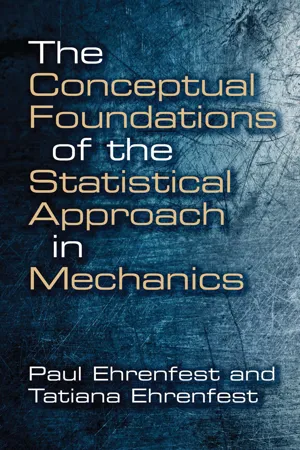![]()
Notes
PREFACE TO THE TRANSLATION
1. I expressed this point of view for the first time in a paper entitled “Zur Axiomatisierung des zweiten Satzes der Thermodynamik” (Zeits. f. Phys., 33 and 34, 1925). A more complete discussion is contained in my book Die Grundlagen der Thermodynamik (Leiden, 1956).
2. Only a few authors take my views into account. The ones I know of are: J. D. van der Waals, Lehrbuch der Thermostatistik, 3d ed., ed. by P. Kohnstamm (Leipzig, 1927); A. Lande, Axiomen tische Begrundung der Thermodynamik (Handbuch der Physik, vol. IX); and lately A. H. Wilson, Thermodynamics and Statistical Mechanics (Cambridge, 1957).
INTRODUCTION, TEXT, AND APPENDIX
1. The number of molecules in 1 cm3 at 0° and atmospheric pressure (i.e., the Loschmidt number) is about 4×1019. (Its value as known today is 2.68709 ± 0.00009×1019.—THE TRANSLATOR)
2. Cf. V 8, Sections 1 and 26 (L. Boltzmann and J. Nabl).
3. These “probability assumptions” are therefore statements about the statistical regularities among the billions of molecules which compose one gas quantum. The position and motion of one molecule is considered here the single event; the behavior of the one given gas quantum is a mass phenomenon. Hence occasionally these older works were also referred to as “statistico-mechanical” studies. Complying, however, with present-day terminology, we will reserve the term “statistico-mechanical” in our discussions to a group of investigations in which the behavior of one gas quantum is considered an individual event and where the behavior of a whole set, to be specified later, of infinitely many copies of such a gas quantum is taken to be a mass phenomenon. All these copies are identical and move independently of each other. (Cf. Sections 9-15.)
4. V 8, Sections 15-25.
5. Boltzmann [6].
6. See Section 6 and V 8, Section 11.
7. Loschmidt [1].
8. Zermelo [1].
9. Section 7.
10. Sections 9-15.
11. Zermelo [3] (1900); Poincaré [3] (1908); Brillouin [1] (1902-1905); Lippmann [1] (1900); Liénard [1] (1903); Burbury, Phil. Mag., (6) 16 (1908), 122.
12. Zermelo [1].
13. Cf. note 15.
14. The arrangement of the next eight sections parallels the treatment in V 8.
15. In the following discussion we will discard the term “the probability of an occurrence” and will replace it by the clumsier but explicit statements about frequencies. It is true that in the older work, which we will discuss now, the uncritical use of the term “probability” proved to be heuristically fruitful. Consider, for instance, the following two different physical quantities: (a) the relative time which a molecule A spends in state S, (b) the relative number of those molecules which at a given time are in state S. These two different frequencies were both described by the expression: “The” probability of A being in state S, and no further differentiation was made. In this way the identity of the two frequencies was implicitly assumed, and this identity was then applied in further considerations. The actual proof of the identity would perhaps have encountered great difficulties, if it could have been done at all. It is unfortunate that this procedure has not been completely eliminated even in the more recent critical studies of the foundations of the kinetic theory. Cf. the beginning of Section 14.
16. Cf. V 8, Section 2.
17. Krönig [1].
18. Because of the special form of the sums which appear in the calculation of the pressure, the Krönig model leads in this problem to the same results as the later, more-refined scheme of Clausius. In other problems, however, such as diffusion and heat conduction, this is no longer the case.
19. The following remarks refer primarily to those papers of Clausius [1, 2], which preceded the first publication of Maxwell [1], on the theory of gases.
20. This statement obviously formulates one of the many meanings in which the expression “the equal probability of all directions of the velocity” has been used. The same can be said about the phrase “the probability that an individual molecule is in a certain specified volume element of the container.” Cf. note 15.
21. Cf. the explanation of this assumption applied to a simplified model in the Appendix of Section 5.
22. Our considerations will be limited, for the sake of simplicity, to spherical molecules. Then the “action sphere” of a molecule is a sphere concentric with the surface of the molecule but having a radius double that of the molecule. It marks the limit of the distance which the centers of two molecules can take before a collision takes place. Cf. Boltzmann, Vorlesungen über Gastheorie y I, §3.
23. For the correct formulation of this purely kinematic part of the problem, see Boltzmann, Gastheorie, I, 15, and V 8, Section 8. For the case of molecules of general structure, see Boltzmann, Gastheoriey I, 107; II, 230.
24. Clausius [2, 3].
2...
